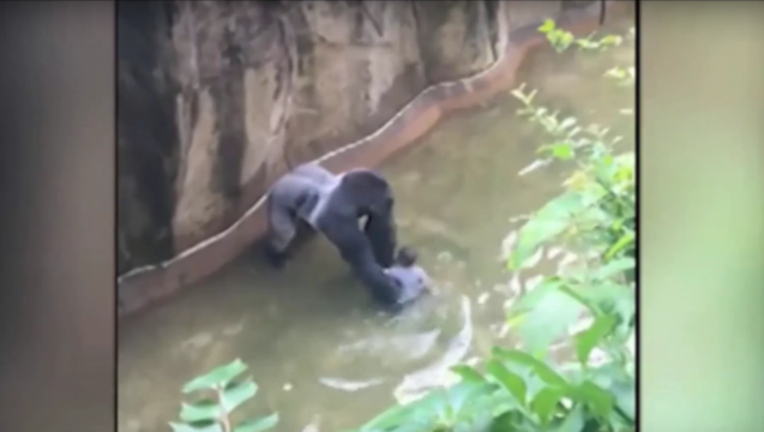Police investigating parents of boy who fell into gorilla enclosure

(Watch Live/YouTube)
CINCINNATI (AP) -- The Cincinnati Zoo, where a gorilla was shot and killed over the weekend after a 3-year-old boy climbed over a fence and fell into its enclosure, has an open viewing area that was among the first of its kind and is now common in many zoos around the country.
The exhibit was at the forefront of zoos moving away from cages in favor of more realistic living environments and adopting a range of exhibits, from natural habitats behind glass walls to jungle-like settings separated from the public by hedges and bamboo fences.
While police in Cincinnati are investigating the child's parents and federal inspectors plan their own review, the zoo says it will look at whether it needs to reinforce the barriers even though it considers the enclosure more secure than what's required.
"The exhibit is safe, the barrier is safe," said zoo director Thane Maynard, who noted the exhibit is routinely checked by federal inspectors and the Association of Zoos and Aquariums, which also plans to investigate what happened.
The breach, the zoo director said, was the first time a visitor had entered the zoo's Gorilla World, which opened in 1978 and was billed as the first "bar-less" outdoor gorilla habitat in the nation.
A federal inspection less than two months ago found no problems with the gorilla exhibit, but earlier inspections reported issues including the potential danger to the public from a March incident involving wandering polar bears inside a behind-the-scenes service hallway.
Some critics have blamed the boy's parents for not keeping a close eye on the child, who is doing fine after being treated at a hospital Saturday, according to his family.
In an update Wednesday, they said the boy had a checkup by his doctor and "is still doing well." The family said they continue to "praise God" and also are thankful to the Cincinnati Zoo "for their actions taken to protect our child."
While they have been blamed for the gorilla's death by some people during a storm of social media and other commentary on the death, the family expressed appreciation for those offering support. The statement said some even have offered money, which they won't accept.
"If anyone wishes to make a gift, we recommend a donation to the Cincinnati Zoo in Harambe's name," said the statement released through publicist Gail Myers.
Myers said the family had no comment on the police investigation.
Police said the investigation will look at the parents' actions -- not the operation of the zoo, which is overseen by the U.S. Department of Agriculture. Police then would discuss with prosecutors whether charges should be filed.
A child endangering charge would be difficult to prove, several legal experts said. Such a charge is typically reserved for parents leaving children unattended for long periods or trapped in hot cars.
"The mother was standing next to a zoo exhibit and lost track of her child for perhaps a minute or so," Ohio State University law professor Ric Simons said. "That has happened to almost every parent in the world in a public place."
At least two animal rights groups were holding the zoo responsible for the death of the 17-year-old western lowland gorilla on Saturday, charging that the barrier made up of a fence, bushes and a moat wasn't adequate.
Most gorilla exhibits around the country now have open-viewing areas -- often protected by a combination of glass walls, mesh netting and moats.
-- Zoo Atlanta, which boasts the nation's largest gorilla collection, has several outdoor viewing spots that are designed to give visitors the feeling of being very close, but they are still separated by a series of safety barriers.
-- Gorillas at the Columbus Zoo are in two enclosed areas behind glass and mesh. The approach is an exception to the type of open enclosure in Cincinnati, which is the industry standard, said spokeswoman Patty Peters.
-- The Smithsonian's National Zoo in Washington has an indoor area with glass walls and an outdoor habitat surrounded by barriers made from a combination of glass panes, metal and metal frames filled in with mesh. Metal railings and large planters also stand between the viewing area.
Child safety expert Kimberlee Mitchell, who runs a childproofing business in southern California called Boo Boo Busters, said attractions need to be made as safe as possible because many people drop their guard at an amusement park or zoo.
But even an attentive parent can be distracted, she said.
"It's unthinkable that a zoo exhibit would be created in such a way that a little 3-old-boy could climb in," she said. "He shouldn't be able to get in there even with his mom's head turned."
------
Seewer reported from Toledo. Associated Press writers Andrew Welsh-Huggins in Columbus and Jessica Gresko in Washington contributed to this report.

